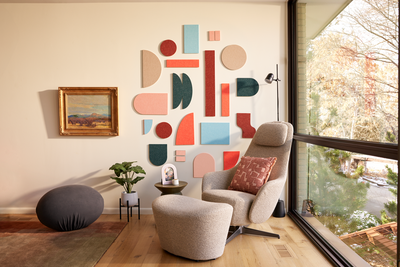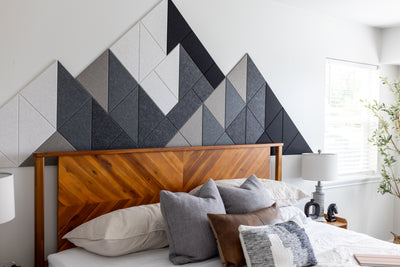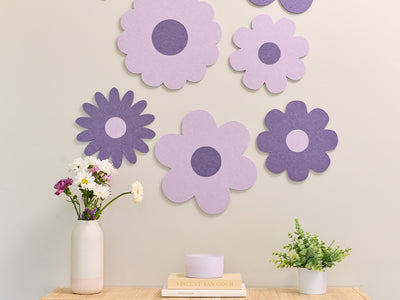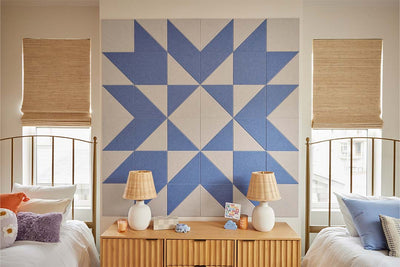Sensory Inclusivity with Felt Right
Whether it’s a classroom, office space, or even your own home, the focus on designing spaces for those with a range of sensory needs has grown.
By utilizing sensory inclusivity strategies in your space, such as installing felt wall tiles, creating a calm-down corner, or using natural light, you can make your home, office, or classroom a more inclusive environment. In this blog, we’re taking a closer look at sensory inclusivity and reviewing some methods and strategies to make your space more welcoming for everyone.

Felt Right is an industry leader in state-of-the-art felt tiles and felt pinboards. If you’re looking for wall décor that not only looks great, but can also improve the sound quality in your space and make it more sensory inclusive, you’ve come to the right place.
Our PET felt tiles come in a range of designs and patterns to ensure that you can create a felt board that suits your unique style and taste. And since our felt wall tiles are so easy to install, you can have your felt board creation completed in a matter of minutes. Colorful. Warm. Sound-dampening. Pinnable. Fun. Transform your walls with Felt Right felt tiles today.
What is Sensory Inclusivity?
Many people may not even be familiar with this term—so let’s start with the basics. What do we mean by sensory inclusivity? According to Jenna Blumke, CCC-SLP, sensory inclusivity means designing “an environment that offers space that is inclusive for those with a range of sensory needs.” She notes that while individuals with autism often benefit from sensory inclusive spaces, this is just one of many populations who could benefit from this sensory inclusivity.
As an example, many school-aged children live with sensory processing disorders, and as a result, may find the traditional classroom environment challenging and distracting. Taylor Sonntag, a Speech Technician Therapist, notes that many children with SPDs are “sensitive to light and sound and will have a harder time in the classroom.” If there is a specific noise, light, or even some patterns or textures that bother them, they may experience sensory overload.
Sensory inclusivity, in this context, means that “schools make sure that there is an awareness for kids with sensory processing disorders” when designing and constructing learning environments. These choices can help students of all different needs find success.

Why Does Sensory Inclusivity Matter?
According to a 2017 study, researchers estimate that roughly 5% to 16% of the general population lives with some type of sensory processing disorder (SPD). Whether the individual is experiencing autism spectrum disorder (ASD), sensory discrimination disorder, or any other type of SPD, certain objects or design features within a space can make it uncomfortable and difficult for them to focus or relax.
This can be especially problematic in environments such as classrooms or office spaces where it’s critical to be able to focus and feel comfortable. But by being aware of different sensory needs, you can work to make your space much more inclusive.
Sensory inclusivity is a major issue in today’s classrooms. According to Taylor, “kids that have SPD will often be tagged in the classroom as having really short attention spans, behavior problems, or even can be seen as intellectually behind.”
This creates a false impression of the student and may impair their ability to learn and work with others. However, there are many sensory classroom ideas and, as Taylor notes, “fixing a stimulus that is bugging a kid with SPD (such as intense, fluorescent lighting) will often fix behavior and attention issues.”
But the need for sensory inclusivity exists beyond the classroom. According to Jenna, “sensory inclusivity matters because it’s our human right to provide individuals with a safe place to learn and reach their goals.” Individuals living with SPDs “struggle enough day to day, so providing an inclusive environment for this population is essential.”
How is Sensory Inclusivity Different from Sensory Friendly?
Sensory inclusive or sensory friendly—what’s the difference? While it’s common to confuse these two approaches to designing spaces, there are key differences. According to Jenna, “the difference is that a sensory friendly environment is one that may offer or be open to exterior sensory devices being used (such as fidgets, bumpy seats, etc.).”
However, a sensory inclusive environment, on the other hand, “is one that has systems already in place to support those with sensory needs.” Additionally, for a learning environment, Taylor notes that integration is a key factor. While there may be some sensory friendly spaces in many schools, developing a sensory inclusive classroom means that “there are sensory friendly elements that help the SPD child be involved in a regular classroom setting.”

Using Felt Tiles to Make Your Space More Sensory Inclusive
Whether it’s a classroom, office space, or your own home, it’s important to make these places as inclusive as possible. However, due to the high costs of some materials, it can be a challenge to put these sensory inclusive plans into action. But luckily, there are many cost-effective ways that you can utilize for your space to make it more sensory inclusive.
If you’re looking for a quick and cost-effective way to make your space more sensory inclusive, consider hanging up some of our Felt Right felt tiles on your walls. Our unique acoustic felt tiles absorb a percentage of incoming sound waves, which helps to reduce ambient noise and improve the overall sound quality in your space. Additionally, installing our felt wall tiles can quickly add warmth and a soft texture to your space. Studies show that soft materials on walls can help those with SPDs feel more comfortable and safe.
Creating a Calm Down Corner for Your Classroom
One of the most effective methods for making a space more sensory inclusive is by designated a calm-down corner. Useful for your home or classroom, a calm-down corner is a designed space with the purpose of providing a safe area for the individual to go to when they feel their emotions are running too high.
A calm-down corner, as the name suggests, provides a physical space to help the individual regain control on both a physical and an emotional level. Calm-down corners can be constructed in a variety of ways, but the majority will use comforting objects (such as pillows or blankets) and soothing materials to promote a sense of calm and safety.

More Ways to Make Your Space More Sensory Inclusive
In addition to installing felt tiles on your walls, there are many other ways to make your space more sensory inclusive. Whether it’s creating a calm-down corner or changing the way you light your space, there are several options available. We’ll break down some of these tips based on sense so that you can better meet the needs of those in your space.
Sight
- Avoid excessively bright and fluorescent lighting
- Make use of natural light when possible
- Use indirect or shaded lights
Hearing
- Offer noise-canceling headphones
- Play soft, non-distracting music in the background (classical music is a popular choice)
- Include a small water feature (the sound of flowing water is relaxing and soothing)
Touch
- Include bean bags or pillows
- Make a small tent for a touch-neutral area
- Weighted blankets
- Soft walls
- Make a sensory bin
Smell
- Avoid items with a strong scent for oversensitive individuals
- Choose one scent (such as lavender) instead of a combination of different smells
What Types of Spaces Commonly Use Sensory Inclusive Designs?
While any space would benefit from a more sensory inclusive design, there are certain places that should be the focus to impact the most individuals with sensory needs. According to our experts, schools, hospitals, child care centers, and therapeutic environments are some of the primary spaces where we currently see sensory inclusive designs in practice.

Conclusion – Sensory Inclusivity with Felt Right
Whether it’s a classroom, office space, or even your own home, it’s important to make design choices that create a space that is as inclusive as possible. When you make sensory inclusive design choices, such as natural lighting or installing felt tiles on your walls, you can help those with a range of sensory needs feel more comfortable in your space.
At Felt Right, we’re proud to offer our felt tiles that can quickly make your space more sensory inclusive. Developed with sound-dampening PET felt, these wall tiles can absorb excess noise to better control unwanted sounds and improve the overall sound quality in your space.
Additionally, the felt material offers a soft and warm feel to your walls, which can benefit those with SPDs. Felt Right felt tiles come in a wide range of colors and designs to suit any style or taste and can help you make your space more welcoming for everyone.
Are you looking to get started? Visit our My Design page today to get started creating your very own felt pinboard for your home, office, classroom, or any other space.








